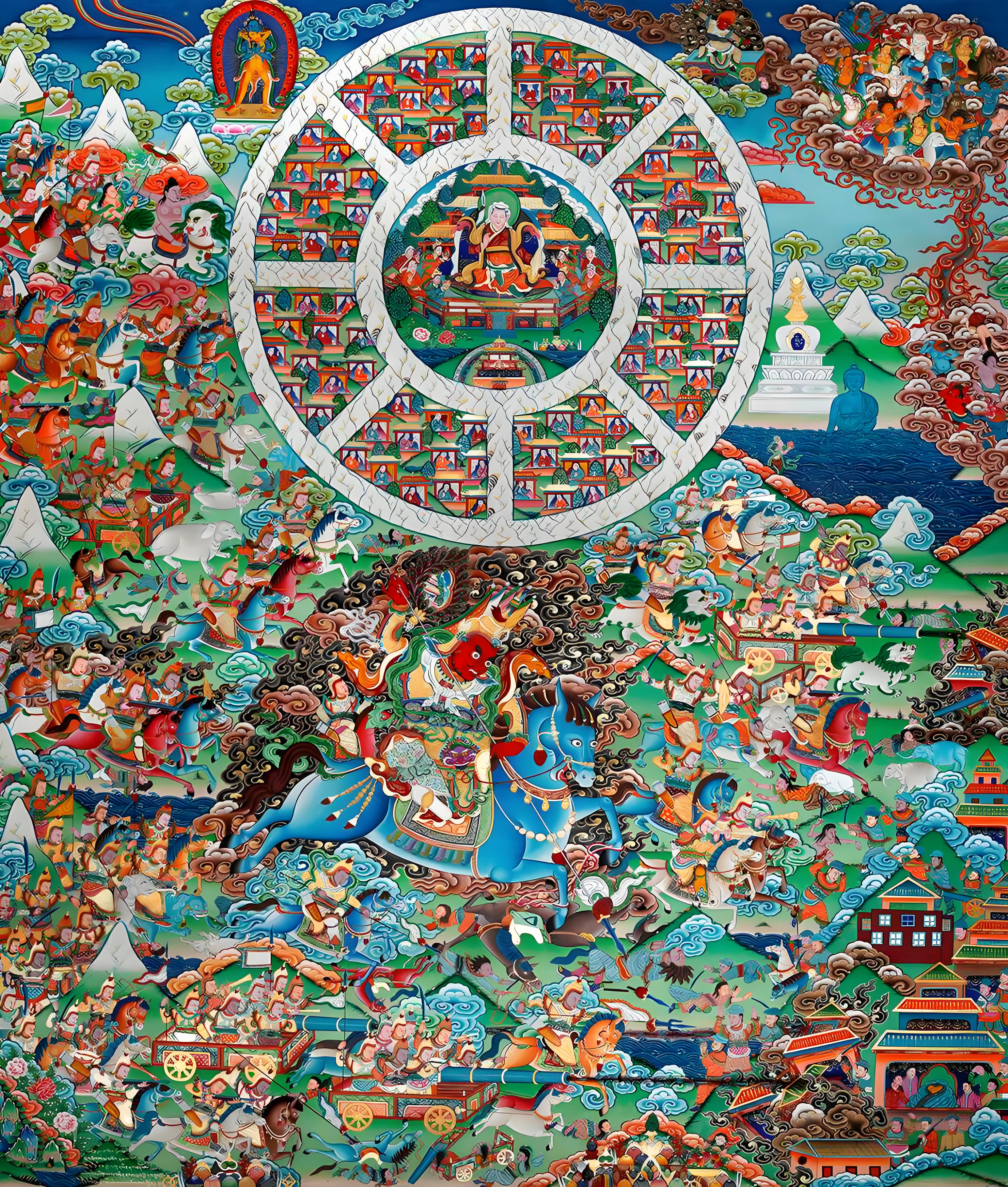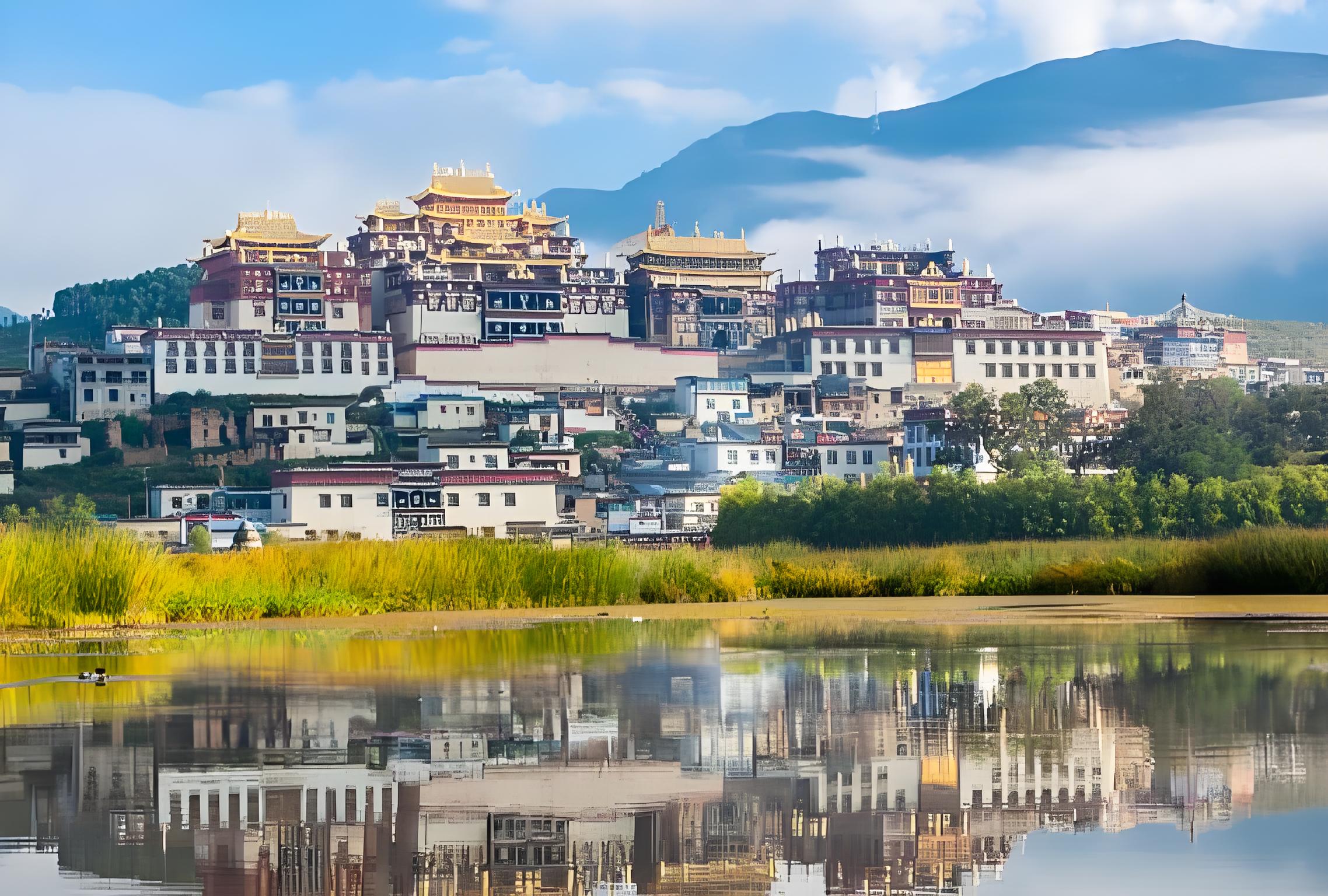Shambhala, a Sanskrit word meaning “place of peace” or “place of tranquility,” is a mythical paradise mentioned in ancient texts, including the Kalachakra Tantra and classical Zhangzhung culture, which predates Tibetan Buddhism in western Tibet. According to legend, it is a land where only those with pure hearts, meaning those who have attained enlightenment, can reside. Thus, the mythical Buddhist kingdom of Shambhala is a place where love and wisdom prevail, and people are untouched by suffering, scarcity, or aging.
The Description of Shambhala in Tibetan Texts
The Tibetan scholar Awang Bandida described the world of Shambhala in his treatise as follows: “It is a sacred land of human holders of wisdom, located in the northern part of Jambudvipa (the human realm). It is round in shape, like an eight-petaled lotus flower. The edges of the center and both sides of the petals are surrounded by snow-capped mountains. The petals are separated by flowing water or snow mountains. There are snow mountains and bald mountains, rocky mountains and grassy mountains, forest mountains and flower and fruit mountains, lakes, trees, and gardens, all arranged in a way that is intoxicating and heartwarming. At the top of the center is the kingdom of Kalapa, and at the center is the palace of the king, the Palace of Jowo, which is so beautiful that even the full moon pales in comparison.”
According to his description, the palace is transparent and bright, illuminating the surrounding area, making it indistinguishable from day and night. The surroundings are as clear as a mirror, and even the images of aquatic creatures swimming within 50 yojanas (an ancient Indian unit of distance) can be seen very clearly. The windows are made of crystal, from which the sun, moon, stars, and the twelve constellations can be seen clearly.
The Significance of Pure Lands in Buddhism
According to the basic theory of Buddhism, sentient beings are caught in the cycle of birth and death in the six realms of existence: gods, humans, asuras, hungry ghosts, animals, and hell, suffering the pain of endless rebirth. Only through the practice of the Dharma, accumulating merit, can one break free from the cycle of rebirth and be reborn in the pure land of a Buddha, which is the greatest wish and goal of beings in the six realms.
Key Pure Land in Tibetan Buddhism
In Tibetan Buddhism, there are various pure lands, such as the Western Pure Land of Amitabha Buddha, the Pure Land of Maitreya Buddha, the Pure Land of Manjushri on Mount Wutai, the Pure Land of Avalokiteshvara on Mount Putuo, and the Pure Land of Rakshasa. Among these, the Shambhala Pure Land, where the Kalachakra deity resides, is extremely important.
This is because when Shakyamuni Buddha, with compassion, taught the Dharma, he revealed 84,000 Dharma doors to meet the various needs of different beings based on their different roots and needs. Among these many methods, the Vajrayana (Tantric) Buddhism of Tibetan Buddhism is considered the pinnacle of the nine vehicles of Buddhism due to its profound teachings, great power, and rapid efficacy.
Within the supreme Vajrayana Buddhism, the “Kalachakra Mandala” is a unique method to quickly purify all of one’s evil karma and increase merit. The first person to receive this Dharma was King Suchandra, the first king of the Kingdom of Shambhala, and from then on, the lineage of the “Kalachakra” and the concept of the “Shambhala Pure Land” began.
It is said that the Pure Land of Shambhala preserves the most complete practice of Shakyamuni Buddha, and many important esoteric transmissions, Dharma treasures, and countless hidden teachings are all kept in the Pure Land of Shambhala.
Historical and Mythological Roots of Shambhala
The legend of Shambhala is said to date back thousands of years, and references to this mythical land can be found in various ancient texts. Bön texts speak of a closely related land called Olmolungring. Hindu texts, such as the Vishnu Purana, mention Shambhala as the birthplace of Kalki, the final incarnation of Vishnu, who believers claim will usher in a new golden age. The Buddhist myth is an adaptation of earlier Hindu myths.
However, the first text to discuss Shambhala extensively is the Kalachakra Tantra. Kalachakra refers to a complex and advanced esoteric teaching and practice in Tibetan Buddhism. It is said that Shakyamuni Buddha taught the Kalachakra at the request of King Suchandra.
The Three Layers of Meaning in Shambhala
Like many concepts in Kalachakra, the concept of Shambhala is said to have outer, inner, and alternative meanings. This makes it difficult for lay people to truly understand the real meaning of Shambhala. The outer meaning understands Shambhala to exist as a physical place, although only those with the appropriate karma can reach it and experience it.
The inner and alternative meanings refer to a more subtle understanding of the meaning of Shambhala in one’s own body and mind (inner) and in meditative practices (alternative). These two symbolic interpretations are often passed down orally between teacher and student.
Shambhala in Tibetan Literature and Art
The Sixth Panchen Lama, Lobsang Palden Yeshe, wrote a popular guide to Shambhala based on the classics in the Tripitaka. In the 16th century, Prince Ngawang Jigda wrote one of the most beautiful and detailed epics in Tibetan literature, describing his journey to Shambhala. Tibetan literature and many books containing medicine and astrology are said to be derived from Shambhala. In Tibetan painting and mural art, Shambhala has become an important subject of expression. Tibetan music also has at least one piece said to come from Shambhala. The beautiful and mysterious Pure Land, derived from Tibetan Buddhism, has thus nourished the spiritual world of generations of Tibetans.
The Ongoing Search for Shambhala
Even today, many followers of Tibetan Buddhism continue to seek proof of the real existence of the Kingdom of Shambhala, proving from various perspectives that Shambhala is somewhere on the snowy plateau. The mysterious and breathtaking scenery of the plateau is constantly presented to the world, and the paradise-like Kingdom of Shambhala is therefore even more mysterious and desirable.
Is Shambhala a Physical Place?
Those with a special karmic connection may actually go there through their karmic connection, but it is not a physical place that we can truly find. We can only say that it is a pure land, a pure land in the human realm. Unless one has the merit and actual karmic connection, one cannot actually reach it.
Although many people have reported being there, no one has yet provided any evidence of its existence, nor has anyone been able to pinpoint its physical location on a map. However, most references place Shambhala in the mountains of Eurasia.
Alternative Locations Proposed for Shambhala
Ancient Zhangzhung texts equate Shambhala with the Sutlej Valley in Punjab or the state of Himachal Pradesh in India. Mongolians equate it with certain valleys in southern Siberia. In the folklore of the Altai, Mount Belukha is considered to be the gateway to Shambhala.
Meanwhile, modern Buddhist scholars seem to have concluded that Shambhala is located upstream in the Himalayas, now known as the Dhauladhar range around Mcleodganj. Some legends say that the entrance to Shambhala is hidden within a remote, abandoned monastery in Tibet, guarded by special creatures.
The Enduring Mystery
For some, the fact that Shambhala has never been discovered has a very simple explanation – many believe that it is located on the edge of physical reality, a bridge connecting this world to the world beyond. While many view it as a subject of myth and legend, for others, the belief in Shambhala ignites an inner longing to one day find this utopian kingdom. content_copy download Use code with caution.


